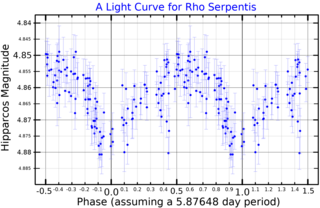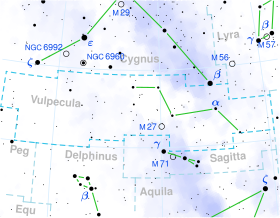
Rho1 Sagittarii, Latinized from ρ1 Sagittarii, is a single, variable star in the southern constellation of Sagittarius. It has a white hue and is visible to the naked eye with an apparent visual magnitude that fluctuates around 3.93. The distance to this star is approximately 127 light years based on parallax, and it is drifting further away with a radial velocity of +1.2 km/s. It is positioned near the ecliptic and so it can be occulted by the Moon.

Rho Serpentis, Latinized from ρ Serpentis, is a single star in the Caput section of the equatorial Serpens constellation. It has an orange hue and is faintly visible to the naked eye with an apparent visual magnitude of +4.78. The distance to this star is approximately 375 light years based on parallax, but it is drifting closer to the Sun with a radial velocity of −62 km/s.

Mu1 Cancri, Latinised from μ1 Cancri, is a variable star in the zodiac constellation of Cancer. The name Mu1 comes from the Bayer naming system: the "1" in the name is because (from Earth) it appears to be close to 10 Cancri, or Mu2 Cancri. It is also known by the variable star designation BL Cancri. The star is dimly visible to the naked eye with an apparent visual magnitude that ranges from 5.87 down to 6.07. Parallax measurements put it about 630 light-years (192 parsecs) from the Sun. At that distance, the visual magnitude is diminished by an extinction factor of 0.28. The position of the star near the ecliptic means it is subject to lunar occultations.

V533 Carinae is a white A-type supergiant variable star with a mean apparent magnitude of +4.59 in the constellation Carina. It is over 10,000 light years from Earth.

23 Vulpeculae is a triple star system in the northern constellation of Vulpecula. It is visible to the naked eye as a faint, orange-hued star with an apparent visual magnitude of 4.52 and it is located approximately 327 light years away from the Sun based on parallax. The system is moving further from the Earth with a heliocentric radial velocity of +1.47 km/s.

15 Vulpeculae is a variable star in the northern constellation of Vulpecula, located approximately 243 light years away based on parallax. It has the variable star designation NT Vulpeculae; 15 Vulpeculae is the Flamsteed designation. It is visible to the naked eye as a faint, white-hued star with a typical apparent visual magnitude of 4.66. This object is moving closer to the Earth with a heliocentric radial velocity of −26 km/s.

29 Vulpeculae is a suspected astrometric binary star system in the northern constellation Vulpecula. It is visible to the naked eye as a faint, white-hued point of light with an apparent visual magnitude of 4.82. The system lies approximately 209 light years away from the Sun based on parallax, and is a member of the IC 2391 supercluster. It is moving closer to the Earth with a heliocentric radial velocity of −17 km/s.

12 Vulpeculae is a star in the northern constellation of Vulpecula, located approximately 630 light years away based on parallax. It has the variable star designation V395 Vul; 12 Vulpeculae is the Flamsteed designation. This object is visible to the naked eye as a faint, blue-white hued star with a baseline apparent visual magnitude of 4.928. It is moving closer to the Earth with a heliocentric radial velocity of -25 km/s.

9 Vulpeculae is a star in the northern constellation of Vulpecula, located about 560 light years away based on parallax. It is visible to the naked eye as a faint, blue-white hued star with a baseline apparent visual magnitude of 5.01. The star is moving further from the Earth with a heliocentric radial velocity of +5 km/s.

V394 Aurigae is a semi-regular variable star in the constellation Auriga. Its brightness varies between magnitudes 6.01 and 6.11, so it is faintly visible to the naked eye under ideal observing conditions. Koen and Eyer found that the star's brightness, as seen by Hipparcos, varies with a period of 3.9 days. Located around 730 light-years distant, V394 Aurigae shines with a luminosity approximately 1075 times that of the Sun and has a surface temperature of 3589 K.

V381 Cephei is a triple star system in the northern constellation of Cepheus. Its apparent magnitude is slightly variable between 5.5 and 5.7.

1 Camelopardalis is a double star system in the constellation Camelopardalis. Its combined apparent magnitude is 5.56 and it is approximately 800 parsecs (2,600 ly) away.

28 Monocerotis is a single star in the equatorial constellation of Monoceros. It has an orange-hue and is faintly visible to the naked eye with an apparent visual magnitude of 4.69. The distance to this star is approximately 450 light years based on parallax, and it has an absolute magnitude of −1.00. The star is drifting further away from the Sun with a radial velocity of +26.7 km/s.

17 Persei is a single star in the northern constellation of Perseus, located about 390 light years away from the Sun. It is visible to the naked eye as a faint, orange-hued star with an apparent visual magnitude of 4.53. This object is moving further from the Earth at a heliocentric radial velocity of +13 km/s.

λ1 Phoenicis, Latinized as Lambda1 Phoenicis, is a double star in the southern constellation of Phoenix. It is visible to the naked eye as a faint, white-hued point of light with a combined apparent visual magnitude of 4.76. The system is located approximately 183 light years away from the Sun based on parallax. It is a member of the Hyades Supercluster.

QW Puppis is a class F3V star in the constellation Puppis. Its apparent magnitude is 4.49 and it is approximately 69.5 light years away based on parallax.

1 Puppis is a single star in the southern constellation of Puppis. It lies in the northern part of the constellation at a distance of about 790 ly, east of Aludra in Canis Major and just north of the white supergiant, 3 Puppis. This object is visible to the naked eye as a faint, red-hued star with an apparent visual magnitude of 4.59. It is moving further from the Earth with a heliocentric radial velocity of +32.4 km/s.

Y Centauri or Y Cen is a semiregular variable star in the constellation of Centaurus.

3 Geminorum is a blue supergiant star in the constellation Gemini. It is a small amplitude pulsating variable and a close double star, with a mean combined apparent visual magnitude of about 5.7.

V520 Persei is a blue supergiant member of NGC 869, one of the Perseus Double Cluster open clusters. It is an irregular variable star. At a magnitude of 6.55, V520 Persei is the brightest member in either NGC 869 or NGC 884, although the brighter HD 13994 lies in the foreground along the same line of sight.














